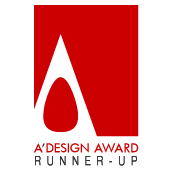"Payring" electronic device Electronic device by Igor Komov |
Home > |
 |
|
||||
| DESIGN DETAILS | |||||
| DESIGN NAME: "Payring" electronic device PRIMARY FUNCTION: Electronic device INSPIRATION: The ring is quite an unusual and high-technological form-factor for the payment device so the design of the rings was to express the innovative and modern aesthetics of the product. UNIQUE PROPERTIES / PROJECT DESCRIPTION: The titanium rings with electronic module that allows a wearer to make wireless payments with a bank card linked to the ring. Each ring has an electronic chip and antenna inside it so it acts like a contactless payment bank card or a transport card. The technology is invented by the Russian company "PayRing". The goal was to design a titanium "shell" for the electronic gear. OPERATION / FLOW / INTERACTION: The ring is basically a passive electronic device (this means that you are not required to charge it). To operate it, you should take the ring close to the payment terminal which is eligible for contactless payments. Also the rings have luminiscent parts. Luminophore absorbs sunlight and artificial light to emit it then in the darkness. PROJECT DURATION AND LOCATION: The project started in April 2019 and finished in September 2019 in Moscow, Russia. |
PRODUCTION / REALIZATION TECHNOLOGY: 3D modelling, 3d printing (SLM technology, titan powder melted with laser), 14k gold inlay, electonic module was placed inside and covered with epoxy resin, UV luminescent lacquer applied onto the grooves in the titan shell. SPECIFICATIONS / TECHNICAL PROPERTIES: Width 22mm x Depth 22mm x Height 6mm. Each ring can be produced in any popular size. TAGS: titan, electronic, contemporary, ring, device, wearable RESEARCH ABSTRACT: The goal was to find a design solution which would be practical (in terms of everyday intensive use) and aesthetically expressive at the same time. Titan has been chosen for its durability and performance characteristics. Minimalistic contemporary look and the use of luminophore were justified by the need to express the hi-tech essence of the product. CHALLENGE: The main challenges of this project included the requirement to fit the electronic module into the metal shell and also the form of the ring was to be suitable for 3d-printing. For example, none of the modern metal printing technologies allow overhanging extensions so we had to round all the angles within the form in order to eliminate right angles. ADDED DATE: 2019-09-20 15:47:03 TEAM MEMBERS (2) : Katerina Komova and Yuri Zotov IMAGE CREDITS: Igor Komov, 2019. |
||||
| Visit the following page to learn more: http://igorkomov.ru/ | |||||
| AWARD DETAILS | |
 |
"payring" Electronic Device Electronic Device by Igor Komov is Runner-up for A' Design Award in Wearable Technologies Design Category, 2019 - 2020.· Read the interview with designer Igor Komov for design "Payring" electronic device here.· Press Members: Login or Register to request an exclusive interview with Igor Komov. · Click here to register inorder to view the profile and other works by Igor Komov. |
| SOCIAL |
| + Add to Likes / Favorites | Send to My Email | Comment | Testimonials |








